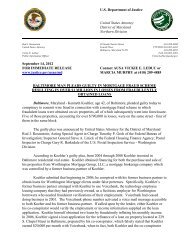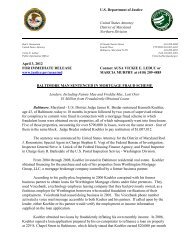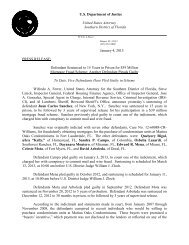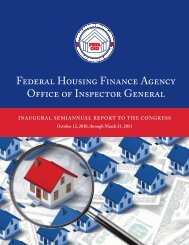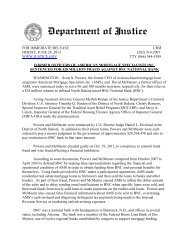FEDERAL
Sixth Semiannual Report to the Congress - Federal Housing ...
Sixth Semiannual Report to the Congress - Federal Housing ...
- No tags were found...
You also want an ePaper? Increase the reach of your titles
YUMPU automatically turns print PDFs into web optimized ePapers that Google loves.
Loan Modification and Principal Reduction<br />
Following the financial crisis of 2008, a number of programs were established to help<br />
homeowners, who had difficulty making their mortgage payments, to avoid foreclosure on<br />
their houses. These programs included a range of possible options to lower a borrower’s<br />
monthly mortgage payment, including a lower interest rate, extension of the loan term, and two<br />
measures involving the outstanding principal of the loan, principal forbearance and principal<br />
forgiveness.<br />
In principal forbearance, a portion of the principal due is set aside and no interest is charged<br />
on that part of the loan for the remainder of the loan term. 184 The portion of the principal that<br />
is set aside is also not amortized; but the debt is not forgiven. Instead, it becomes a balloon<br />
payment that falls due when the owner sells the property, pays off the interest-bearing unpaid<br />
principal balance, or at the maturity of the original mortgage loan. 185<br />
In contrast, principal forgiveness results in a reduction in the amount the borrower owes. In<br />
addition to lowering the monthly payment, principal forgiveness usually results in the borrower<br />
having an improved equity position in the home as a consequence of having a lower loan<br />
balance. Equity is the difference between the actual value of the home and the amount the<br />
borrower still owes. Having increased equity can make it easier to refinance or sell the home. 186<br />
HAMP, one of the aforementioned foreclosure avoidance programs, was authorized by Congress<br />
under EESA in an effort to help struggling homeowners. In May 2013, the program was<br />
extended to December 31, 2015. 187<br />
HAMP provides for Treasury, through the GSEs, to offer financial incentives to mortgage<br />
servicers and borrowers to reach agreements on loan modifications. 188 The program is available<br />
to owner-occupants who owe up to $729,750 on their primary residence or one-unit property;<br />
$934,200 on a two-unit property; $1,129,250 on a three-unit property; or $1,403,400 on a<br />
four-unit property. The borrower has to be delinquent on the mortgage or default has to be<br />
“reasonably foreseeable.” 189<br />
Under HAMP, payments on the mortgage are reduced to 31% of the borrower’s gross monthly<br />
income by first reducing the interest rate on the mortgage, going down to a possible floor of<br />
2%. If that is not sufficient to reach the 31% goal, the loan term can be extended up to 480<br />
months. Finally, the servicer can offer principal forbearance, which delays repayment of part of<br />
the principal without requiring interest payments on that part. 190<br />
The mortgage servicer applies a mathematical formula to compare the net present value<br />
(NPV) of the house with loan modification with the NPV without modification of the loan. The<br />
NPV calculation, which was designed by Treasury, FHFA, FDIC, and other experts, is designed<br />
to determine if it will be more profitable for the servicer to modify the mortgage or foreclose.<br />
Under the rules, if a servicer will make more money by modifying the loan, resulting in a<br />
66 Federal Housing Finance Agency Office of Inspector General



